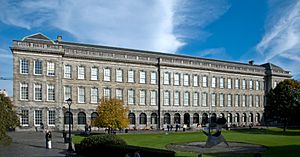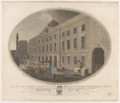Thomas Burgh (1670–1730) facts for kids
Quick facts for kids
Thomas de Burgh
|
|
|---|---|

Old Library Building, Trinity College, Dublin
|
|
| Surveyor General of Ireland | |
| In office 1700–1730 |
|
| Preceded by | William Robinson William Molyneux |
| Succeeded by | Edward Lovett Pearce |
| Lieutenant-General of the Ordnance | |
| In office 1705–1713 |
|
| Preceded by | Chidley Coote |
| Succeeded by | Richard Molesworth |
| Member of Parliament for Naas | |
| In office 1713–1730 Serving with Theobald Bourke
|
|
| Preceded by | Alexander Gradon James Barry |
| Succeeded by | Thomas Burgh John Bourke |
| Personal details | |
| Born |
Thomas Burgh
1670 |
| Died | 18 December 1730 (aged 59–60) |
| Nationality | British |
| Spouse |
Mary Smyth
(m. 1700) |
| Children | 9, including: Thomas Burgh Richard Burgh |
| Parents | Rt Rev Ulysses Burgh Mary Kingsmill |
| Relatives | Ulysses Burgh, 2nd Baron Downes (grandson) |
| Alma mater | Trinity College, Dublin |
| Military career | |
| Allegiance | |
| Service/ |
|
| Years of service | 1688–1730 |
| Rank |
|
| Unit | Lord Lovelace's Regiment of Foot |
| Commands held |
|
| Battles/wars |
|
Colonel Thomas Burgh (1670 – 18 December 1730) was an important person in Ireland during the 1700s. He was a skilled military engineer and a talented architect. He also served as a Member of Parliament in the Irish government.
Thomas Burgh was the Surveyor General of Ireland from 1700 to 1730. This meant he was in charge of many building projects across the country. He designed several famous public buildings in Dublin. These include the old Custom House, the Trinity College Library, Dr Steevens' Hospital, the Linen Hall, and the Royal Barracks.
Contents
Early Life and Military Career
Thomas Burgh was born in 1670. His father, Ulysses Burgh, was a church leader. His mother was Mary Kingsmill. Thomas had two brothers who also became Members of the Irish Parliament.
Thomas went to school in Dublin and then to Trinity College, Dublin. He didn't finish his degree there. When wars broke out in 1688, he likely moved to London with his father.
He later returned to Ireland as a soldier with King William III's army. He fought in the Siege of Limerick. He also served as a Captain in the Royal Regiment of Foot. He fought in battles in the Low Countries, like the Battle of Steenkerke (1692) and the Battle of Landen (1693). He also worked as an engineer during the Siege of Namur in 1695. During this time, he learned a lot from a famous Dutch engineer named Menno van Coehoorn.
In 1700, Thomas Burgh became the Surveyor General of Ireland. This was a very important job where he oversaw many building projects. A year later, he also became the Barracks Overseer. Under his leadership, many new army barracks were built. He also finished rebuilding Dublin Castle. He repaired other important buildings and coastal forts too.
Public Service and Influence
In 1704, the City of Dublin honored Thomas Burgh for his work on the city's buildings. He also joined the Dublin Philosophical Society, a group for thinkers and scientists.
From 1713 to 1730, he was a Member of Parliament for Naas. This meant he helped make laws for Ireland. He also held other important roles, such as High Sheriff of Kildare in 1712. He was a governor of the Royal Hospital Kilmainham and a trustee for Dr Steevens' Hospital.
From 1705 to 1714, he was the Lieutenant-General of the Ordnance for Ireland. This job, combined with being Surveyor General, made him very powerful in overseeing military construction and other public works. He kept his role as Surveyor General for 27 years.
Architect of Dublin
Thomas Burgh designed many famous public buildings in Dublin. His work helped shape the city's look.
Notable Buildings Designed by Burgh
- The Custom House (1704–1706): This building was used for collecting taxes on goods. A newer Custom House was built later.
- Trinity College Library (1712–1733): This is a beautiful and historic library at Trinity College, Dublin.
- Dr Steevens' Hospital (1719): A hospital that still stands today.
- Linen Hall (1722): A large building where linen was traded.
- Royal Barracks (started 1701): A major army barracks, now a museum.
- The Armoury at Dublin Castle: A place to store weapons.
- Chapelizod House: A royal residence.
- St. Luke's Church, Dublin: A church in Dublin.
- Collegiate School Celbridge: A school building.
- Ballyburley House: Another building he designed.
He also designed several churches, including St Mary's Church and St Werburgh's (1715). He built some private homes too, but most of them no longer exist.
His own country house, Oldtown, near Naas, was special. It was the only building where he used some Palladian design ideas. He bought the land in 1696 and built the house 13 years later. His style was usually "restrained," meaning it was simple and elegant. He often used a central front with a large triangle-shaped top (pediment). Oldtown remained his family home. He also designed Kildrought House nearby.
Thomas Burgh also worked on engineering projects. He helped improve Dublin Harbour. He also planned the Newry Canal, though it was built after he died. He even wrote a pamphlet about how to measure land.
In 1728, he lost the chance to design the new Parliament House in Dublin. This job went to Edward Lovett Pearce, who later took over Burgh's role as Surveyor General after Burgh died in 1730.
Family Life
Thomas Burgh married Mary Smyth in 1700. They had five sons and four daughters. His home in Dublin was on Dawson Street. His country estate was Oldtown in County Kildare. He also owned valuable coal mines in County Antrim.
Some of his children included:
- Thomas Burgh (1707–1759), who became a Member of Parliament like his father.
- Richard Burgh (died 1762), who was a lawyer and also became a Member of Parliament.
His grandson, Ulysses Burgh, 2nd Baron Downes, later changed the family name to "de Burgh" in 1848.
Images for kids
-
Dr Steevens' Hospital, Dublin
-
Main Square of the (Royal) Collins Barracks, Dublin
-
Kildrought House, Celbridge, Ireland
-
Old Library Building, Trinity College, Dublin
-
A view of the Linenhall, Dublin from around 1782 by the engraver Robert Pollard
| Parliament of Ireland | ||
|---|---|---|
| Preceded by Alexander Gradon James Barry |
Member of Parliament for Naas 1713–1730 With: Theobald Bourke |
Succeeded by Thomas Burgh John Bourke |
| Honorary titles
|
||
| Preceded by Sir Kildare Borrowes |
High Sheriff of Kildare 1712–14 |
Succeeded by Brabazon Ponsonby |
| Political offices | ||
| Preceded by William Robinson William Molyneux |
Surveyor General of Ireland 1700–1730 |
Succeeded by Edward Lovett Pearce |
| Preceded by Chidley Coote |
Lieutenant-General of the Ordnance 1705–1713 |
Succeeded by Richard Molesworth |







